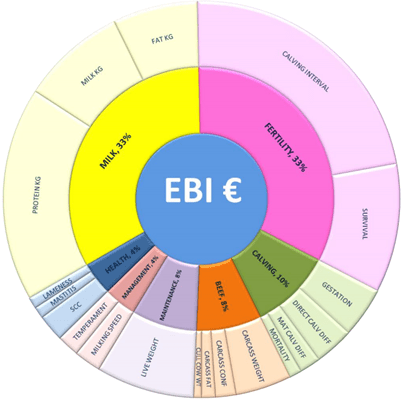One of the measures that farmers can adopt and implement on their dairy farm to reduce emissions is the use of the Economic Breeding Index (EBI).
Reducing emissions has become extremely important, with every person and every sector having to play their part.
The EU has set Irish farmers significant targets of reducing greenhouse gas (GHG) emissions, with agriculture currently accounting for 33% of Ireland’s GHG emissions.
GHG emissions from agriculture are difficult to reduce, but according to the Irish Cattle Breeding Federation (ICBF), farmers who adopt certain practices and technologies can significantly improve efficiency, improve profitability, and lower GHG emissions.
EBI
According to ICBF, the EBI will help farmers breed a more profitable dairy cow and lower GHG emissions.
Research by Teagasc has shown that for each €10 gain in herd EBI, there has been a gain of €20 in terms of additional net profit/cow/year – while also reducing emissions by 3%.
The EBI is a tool to help identify profitable animals. It has been in existence for almost 20 years and has been widely adopted by Irish farmers.

Source: ICBF
How does it work?
Increasing the genetic merit of your herd through EBI has the capacity to reduce emissions through a number of ways.
Higher EBI animals are more fertile, which reduces the replacement rate of your farm and should also reduce the calving interval. This in turn, reduces methane emission produced/unit of product.
Increased levels of fertility will also mean that more heifers will calve down at the optimum age of between 22-26 months. This reduces the amount of time in which the animals remains ‘idle’ in her lifetime.
Along with improved fertility, higher EBI animals have an increased milk yield and composition. This increases the efficiency of production, which once again decreases emissions/unit of product.
Having a more compact calving for a spring-calving herd means you can maximise the proportion of grazed grass in the cow’s diet, which improves production efficiency.
The use of the EBI breeding tool can also lead to improved health status within your herd. The use of EBI reduces the incidence of disease, leading to higher production levels and lower replacement rates, thereby lowering GHG emissions.
The health sub-index can be used to identify bulls that will breed healthier cows.
Lastly, the levels of feed intake are an important element influencing methane production.
A smaller cow consumes less feed than larger cows, with the maintenance sub-index in the EBI capturing the cow size using cow liveweight.
This can be used to breed a more carbon efficient cow that produces high kgs of milk solids.
